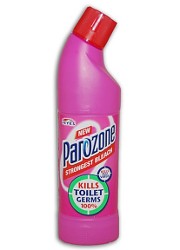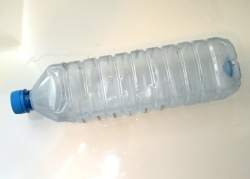How can I reuse or recycle bleach bottles?
 Inspired by clearing out of bathroom cupboards this morning, I thought we’d have a cleaning themed week here on Recycle This. We’ve covered various cleaning related things in the past – pump action spray bottles, washing powder packaging, “freshener” shakers and reducing the amount of cleaning products used – but there are still a few things we could think about reusing, recycling, upcycling & reducing.
Inspired by clearing out of bathroom cupboards this morning, I thought we’d have a cleaning themed week here on Recycle This. We’ve covered various cleaning related things in the past – pump action spray bottles, washing powder packaging, “freshener” shakers and reducing the amount of cleaning products used – but there are still a few things we could think about reusing, recycling, upcycling & reducing.
We’ll talk about more specifically cleaning alternatives later in the week but bleach, and so bleach bottles, is a candidate for reduction. There are alternatives to such harmful stuff in plastic bottles. But some people are a bit “prise it from my cold dead hands” about bleach and will never be parted from it, no matter what us vinegar loving hippies say.
All the ones I’ve checked have been made from HDPE – type 2 plastic – and most areas that collect plastic collect resin code 2 plastics so they can be recycled but I think reuses might be harder to identify. They feel less reusable than, say water bottles or pop bottles – because of the chemical residue, because they’re thick opaque plastic and in the case of some of them, a quirky bent neck for getting under toilet rims.
Anyone got any reusing/upcycling ideas though? Do you do anything with yours or do you just throw them into your recycling bin?























for plain bleach bottles
Scrub/rinse out very well, then:
Cut off the top for a funnel, use the bottom for seed starting
Use the bottom for mixing anything you don’t want to contaminate a good
receptacle
Make a piggy bank or other creature bank – lots of directions on line
Use for a fertilizer/compost tea watering can
Cut off the top for a funnel, put in the top of the cut off bottom, collect rain
water – either just set out in the rain or under a drip (we have a seam in
the gutter that drips, even with just condensation)
Presuming through cleaning and definately NOT using for food-
Coloured plastic, like that pictured could make:
Great craft material.
Plant labels.
Colour coded storage for lots of beads, buttons, nails, screws.
Cut down a bit for pens and pencils.
Water play toy -where children are old enough to know not to play with the it in original use.
Other uses:
Recepticle for toxic products such as waste oil.
Mixing container (after cleaning of course) for liquid fertiliser or insecticide (not that we hippies use that)
If the diameter of the bottle is as big as that of your toilet brush, you can make a toilet brush holder out of it. You can see how here
http://www.thriftyfun.com/tf91371373.tip.html
I recommend that you leave the top of the neck intact except for a single, vertical slit so you can push the brush handle into it to secure it.
Can anyone find any info on exactly how toxic bleach is, either to the environment or to someone, say, eating out of a bleach container after it has been washed?
Hydrogen Peroxide can be produced naturally – leaving barley straw in water produces it, which is recommended as a way of harmlessly killing off algae in ponds.
Drinking water is treated by bubbling chlorine gas through it – you can taste the chlorine in tap water sometimes, and it kills off water borne diseases.
Obviously large amounts of bleach, or undiluted bleach, are NOT good to eat, but very small very diluted amounts are fine, and in fact kill off harmfull bugs. So I wonder how much is too much? Just how careful do we need to be when reusing bleach bottles?
Civil Defense advise here is:
If water cannot be boiled, add one teaspoon of bleach to 10 litres of water and leave it for 30 minutes.
So a bit of residue in a well rinsed bottle that is then refilled with drinking water is not a problem UNLESS someone (e.g. child) sees you using a bleach bottle for a consumable product and decides to consume the contents of another bleach bottle.
I’ve always applied the rule to never put food into containers that contained dangerous non-consumable products for the above reason, just not worth the risk. Even an adult could make a mistake with clear liquid e.g. a diluted insecticide, in a normal water bottle.
They can be made into wonderful scoops for peat moss, potting soil, etc.
Use a felt-tip pen to draw your cutting line on plastic bottle. Handle facing upward, draw along top of cylindrical “body” about 1/3 of diameter with handle at center.
Draw a gently curved line down each side towards bottom, and around approximately 1/3 of base on side opposite handle.
Puncture area to be removed with a pair of scissors to start your cut, then cut along marked line.
You could always use those quirky bent-neck bottles for squirting vinegar in your toilet bowl, after you’ve sworn off the toxic chemicals.
There is a porosity even with plastics. I would not eat out of them. I do know when we tap the trees for mapale syrup at Chicago’s only nature center, we reuse only water gallon jugs…NOT milk…even though everything is rinsed out…the bacteria can leach into the plastic is what I am told by the scientists working on staff.
we collect the sap over a months time, and then boil it for at least 10 hours over a hot wood fire, but they still tell us only to reuse the gallon water jugs.
Please note….many plastics are NOT “food safe.”
I love bleach, (I live in Malta and we bleach or go mouldy). I choose the colours of the bottles with a view to cutting them up into wonderful plant labels for all the veggies I grow from seed, Dilute and residue bleach isn’t really toxic. Think of what you soak baby bottles in….bleach.
I feel sure that they would make good swing labels, even gift tags.
xx
i love bleach too
I cleaned out a small white bleach bottle w/no handle and cleaned the label off. Then I cut the top part just 1/2 way across. With the taller back part I punched a hole in it. I filled it with dirt and flowers and hung it on a long S hook on my privacy fence.
I always hated to toss the empty plastic containers for softeners, laundry soap and other similar products. I decided that the lid could be used for different craft projects.
Here’s a few; put some rocks in the bottom of the lid for weight, cover with batting, cover with material to form a large ball that is about 2 inches above the lip. You can now glue material or other items such as buttons on the outside and you have a cute pin cushion.
The smaller lids can be used as hats for your crafts, like for a snowman.
The containers can be put over plants in your garden when there is a chance of frost. I wouldn’t recommend the ones that hold bleach.
My husband uses them to hold the old oil and transmission fluid when he changes them.
I would like to know any other ideas someone might have for them.
Heston Carpet Cleaners Ltd.
Can u recycle harpic bottles
I reuse bleach bottles for emergency water storage. I live in a very rural area. Sometimes my electric power goes out for days. I have a well so at my house no power = no water supply.
To get rid of mall in a garden, stick used bleach bottle into his path and strong smell will scare the root–eating animal away.